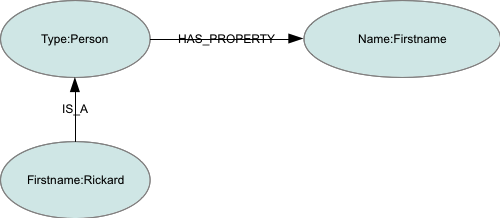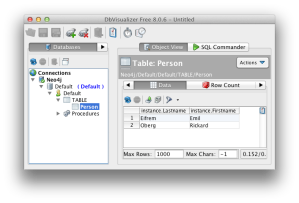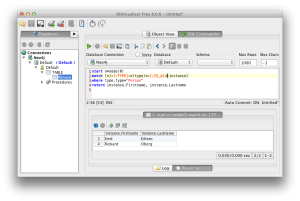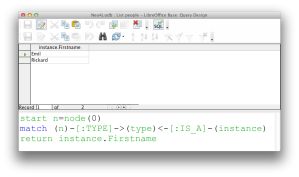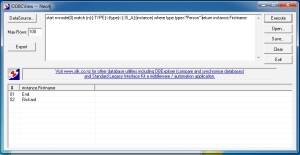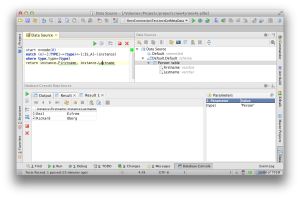This is probably the most difficult blog post I have ever had to write. In part, because the subject matter, of evil and it’s expression in a school environment, is something that most people simply don’t know about or understand, and in part because I have quite a lot of empirical data from St John’s Institution in Kuala Lumpur (SJI) and through discussions with other teachers, parents and students from other schools, to draw from. To compress this huge subject into a blog post, while still making it clear enough for concerned readers to comprehend, seems impossible to me. But given the severity of the issue, I will at least try, and hopefully discussions later can clarify any missing points.
There is also the question of whether the data I have from SJI, an all-boys public school, can be generalized to other schools, and the education system at large. As I hope to show, I think it can to quite some extent, but more importantly, if the feedback from my first post is anything to go by, You will be able to help provide any missing pieces. I have faith in the notion that once someone points out that the Emperor have no clothes, others will be able to see it as well.
I am also aware of that this blog is definitely TL;DR material, and that I tend to use way too many uncommon words. To help with that read it in steps if you like, and I’ve tried to link as many of the difficult and technical words as possible to their definitions, where you can learn their meaning, if need be.
The big picture
So let’s get on with it. The first part in this series described the industrial background of the education system, in Malaysia and elsewhere, and how it’s design is no longer relevant in our current society, and that what it aims to produce, grade-A students, has little to no actual real value and does nothing to fulfill the purposes of a good education system.
At the end of the first post I stated that anyone who thinks the current system is good should be labeled “evil industrial globalists”, or at the very least they have these as their ideological buddies, whether they want to or not.
Whereas the first post discussed the industrial aspect, this second post will focus on the Evil part of that label. Since there exists a, more or less, clinical understanding of what Evil means, which is quite different from the colloquial every-day use of the word, I want to begin to explain exactly what I mean when I use the word “evil”.
The understanding and analysis below is going to be based on the field of psychology and its study of pathology – such as psychopathy/sociopathy, pathological narcissism, and schizophrenia – both in the individual and macrosocial sense. It will also focus on what happens to “good” people (i.e. people who under normal circumstances would not behave in “evil” ways) when they are subjected to systems created for the purpose of generating evil people and acts.
The two main books I have used for references and understanding are on the one hand “The Lucifer Effect” by Phil Zimbardo, which describes in detail how this second aspect works: how good people turn evil when put into an evil system, and on the other hand I have used “Political Ponerology” by Andrew M. Lobaczewski, which describes in detail how pathological individuals group together and give birth to said evil systems. These two books naturally complement each other, and should be read and understood by anyone wanting to understand what is happening to the Malaysian education system, or other systems which exhibit the same symptoms and problems.
What is evil anyway?
The concept of “evil” is a widely used and misunderstood term, and so let’s begin by stating what it means. Here is one definition from “The Lucifer Effect”:
Evil consists in intentionally behaving in ways that harm, abuse, demean, dehumanize, or destroy innocent others – or using one’s authority and systemic power to encourage or permit others to do so on your behalf.
or in short:
Evil is knowing better but doing worse.
As should be apparent, schools are a very obvious place where evil can occur, as there is abundant authority and systemic power to be abused, and very little consequence of doing so, as the ones who are abused, children, have little to no way of escaping said abuse. With great power comes great responsibility, indeed.
Another, slightly more complex, way of looking at evil can be found in the foreword to “Political Ponerology”, where it is put like this:
What is evil? Historically, the question of evil has been a theological one. Generations of theological apologists have written entire libraries of books in an attempt to certify the existence of a Good God that created an imperfect world. Saint Augustine distinguished between two forms of evil: “moral evil”, the evil humans do, by choice, knowing that they are doing wrong; and “natural evil”, the bad things that just happen – the storm, the flood, volcanic eruptions, fatal disease.
And then, there is what Andrew Lobaczewski calls Macrosocial evil: large scale evil that overtakes whole societies and nations, and has done so again and again since time immemorial. The history of mankind, when considered objectively, is a terrible thing.
Death and destruction come to all, both rich and poor, free and slave, young and old, good and evil, with an arbitrariness and insouciance that, when contemplated even momentarily, can destroy a normal person’s ability to function.
Over and over again, man has seen his fields and cattle laid waste by drought and disease, his loved ones tormented and decimated by illness and human cruelty, his life’s work reduced to nothing in an instant by events over which he has no controls at all.
These are the definitions of evil that I will use from now on, as they focus properly on the two things that are needed to understand what is going on: how pathological individuals create evil systems, and how normally good people in these evil systems proceed to do evil things to other people, specifically how teachers abuse students in a school environment.
Of 5-year-olds and crocodiles
Before we delve into the examples of evil, it is also important for you, the concerned reader, to have at least a cursory understanding of what I mean with “pathological people”, and specifically “psychopaths”. This is another widely used and misunderstood term, which now is reasonably well understood in clinical circles. Most people I meet understand it in the “Evil Genius in Hollywood Movies” sense, or use it as shorthand for “people I really don’t like”.
This is quite far from the truth, and having a more clear sense of what it means is necessary before we go on. I’m going to quote from Martha Stout’s book “The Sociopath next door” to give you a sense of what a psychopath is, and what their mind looks like:
Imagine – if you can – not having a conscience, none at all, no feelings of guilt or remorse no matter what you do, no limiting sense of concern for the well-being of strangers, friends, or even family members. Imagine no struggles with shame, not a single one in your whole life, no matter what kind of selfish, lazy, harmful, or immoral action you had taken.
And pretend that the concept of responsibility is unknown to you, except as a burden others seem to accept without question, like gullible fools.
Now add to this strange fantasy the ability to conceal from other people that your psychological makeup is radically different from theirs. Since everyone simply assumes that conscience is universal among human beings, hiding the fact that you are conscience-free is nearly effortless.
You are not held back from any of your desires by guilt or shame, and you are never confronted by others for your cold-bloodedness. The ice water in your veins is so bizarre, so completely outside of their personal experience, that they seldom even guess at your condition.
In other words, you are completely free of internal restraints, and your unhampered liberty to do just as you please, with no pangs of conscience, is conveniently invisible to the world.
You can do anything at all, and still your strange advantage over the majority of people, who are kept in line by their consciences will most likely remain undiscovered.
How will you lead your life?
What will you do with your huge and secret advantage, and with the corresponding handicap of other people(conscience)?
The answer will depend largely on just what your desires happen to be, because people are not all the same. Even the profoundly unscrupulous are not all the same. Some people – whether they have a conscience or not – favor the ease of inertia, while others are filled with dreams and wild ambitions. Some human beings are brilliant and talented, some are dull-witted, and most, conscience or not, are somewhere in between. There are violent people and non-violent ones, individuals who are motivated by blood lust and those who have no such appetites…
Provided you are not forcibly stopped, you can do anything at all.[…] Crazy and frightening – and real, in about 4 percent of the population.
[…] The high incidence of sociopathy in human society has a profound effect on the rest of us who must live on this planet, too, even those of us who have not been clinically traumatized. The individuals who constitute this 4 percent drain our relationships, our bank accounts, our accomplishments, our self-esteem, our very peace on earth.
[…] What differentiates a sociopath who lives off the labor of others from one who occasionally robs convenience stores, or from one who is contemporary robber baron – or what makes the difference between an ordinary bully and a sociopathic murderer – is nothing more than social status, drive, intellect, blood lust, or simple opportunity.
What distinguishes all of these people from the rest of us is an utterly empty hole in the psyche, where there should be the most evolved of all humanizing functions.
Some of you reading the above will get a chill down your spine going “OMG! I know people like this!”. Yet others will think to themselves “NO, we are all born Good, and Love and Light will fix anything that is not so”. And some of you will think:”sure, that is my life, and I love it! So what?”. This post is written for the first group. If you fall into the other two categories, you can stop reading now, as you will not get much out of it anyway.
The ability of psychopaths to hide in plain sight, as we all project our own conscience on the intent and actions of others (“I’m sure he meant well”), is an amazing feat, and is a key reason why they can stay in relative hiding, whether they be criminals, teachers, CEO’s or presidents. They all share the same black hole in their mind, which they continuously try to fill with money and power. But it never fills up, and so they continue until they are stopped or die.
Even though it is useful to have a clinical view of what psychopaths are, and how they work, sometimes it is necessary to lighten things up and make fun of things. Humor is a great asset against evil. So, in my family we have adopted two other terms for psychopaths, that we use when we talk about these things.
One is “5-year-olds” (with due apologies to 5-year-olds), in the sense that psychopaths tend to behave a lot like little children. They always want want want, don’t really care about other people, and usually have a really unrealistic and childish view of how the real world works. To them, reality is what they can convince other people, and that makes it real in their mind.
The other term we use is “crocodile” (and again due apologies to real crocodiles by the way), and the reason for this is that like crocodiles, psychopaths simply follow their nature in doing all these evil things. It’s what they are, and what they are really good at. Like crocodiles they don’t feel bad when they “eat” other things, and like crocodiles it is a good idea for real humans, with consciences and empathy, to simply stay away from them. There is also no need to pity crocodiles for being what they are, wishing that they were “normal”. They certainly don’t think so, and they firmly believe that WE normal humans are the weird ones, having this idiotic conscience that holds us back. A crocodile is a crocodile is a crocodile, and they just do what crocodiles usually do: they kill and eat other things that happens to be close to them. Like psychopaths they are a part of nature, and we simply have to accept that they are there, and deal with them appropriately in a way that minimizes evil.
The many faces of evil
Now that you have some idea of what I mean with the words “evil” and “psychopath”, let’s get into the details of what this can look like in a school environment. Below I will enumerate a number of such examples from SJI and elsewhere that I am aware of, both big and small. Later I will try to give you a big picture idea of what it all means.
I should also preface this by saying that both students and a majority of teachers are victims in all of this. I doubt that this reality is what the teachers had in mind when they opted for this career, and that most of them are as sick of it as I am, but have had to adapt to it and endure, as a survival strategy. They are the proverbial good apples put into bad barrels.
Breaking the spirit
The first step towards creating a successful evil system is the breaking of the spirit. This is done by breaking the body, breaking the emotions, and finally, breaking the mind. Once that has been achieved, and the spirit of a student has been broken, the next steps can be taken.
Below are examples of this, mostly taken from SJI. Whether they are specific to SJI, or occur in other places as well, I’m hopeful that we will find out in the comments section. Some of these strategies are mandated by the Ministry of Education, and can therefore safely be said to be generally applicable.
Step 1: Breaking the body
The first step is inducing sleep deprivation, so that students are constantly tired and not able to think and resist. The way this is done in Malaysia is to have “morning sessions”, which start at roughly 7AM, which means that our kids have to get out of bed at 5AM, to get ready and take the trip to the school, hoping to beat the rush hour morning traffic. To say that they are constantly tired and drowsy is an understatement.
When they are in the classroom, the sound level is so high that the brain has no choice but to shut out sounds. I did an experiment whereby I was at one end of a normal SJI classroom, and my wife was in the other end. She could hear me whisper. These acoustics are great if you are building a classical Greek theater, but in a classroom of 30+ students, and a teacher that tries to overcome this kind of noise, it is a nightmare. No real education can be done in such an environment, regardless of the teachers’ intents.
The rooms are constructed out of hard surfaces, with no sound absorption, and so the minutest of sounds make a huge impact. In a good office environment this would never be tolerated, as it would impact the performance of work greatly, but this is the environment in which our kids are supposed to learn and study. It’s deplorable, and causes severe dissociation and daydreaming, as an escape from this madness.
Next up, the food that is made available should be such that is helpful for a growing body that needs to concentrate and think. In SJI the choice of food is anything but.
Do you like pizza? How about a nice cheese burger? Some of you might even admit to being fast food junkies! And that is actually not far from the mark. Both wheat and milk, which are used in bread and cheese (which when combined gives us pizza, cheese burgers and lasagna), contain proteins that when digested produce forms of morphine, that gives you a narcotic high. Here is one report on this:
[…]Opiates hide inside casein, the main dairy protein. As casein molecules are digested, they break apart to release tiny opiate molecules, called casomorphins(sic). One of these compounds has about one-tenth the opiate strength of morphine. The especially addicting power of cheese may be due to the fact that the process of cheese-making removes water, lactose and whey proteins so that casein is concentrated. Scientists are now trying to tease out whether these opiate molecules work strictly within the digestive tract or whether they pass into the bloodstream and reach the brain directly.
As you will find by looking for studies and articles on the subject, there is some debate as to the extent to which these opiates influence our bodies. There is also quite a lot of studies showing links between wheat- and milk-based products and (for example) schizophrenia and autism, which is my main concern for the purpose of this post. Food products containing wheat and milk are abundant in school canteens. So why on earth are we serving food to kids that have these effects? I thought “intoxication” and doing drugs was a no-no? Apparently not.
Now, if you want healthy and thinking students, the above would seem like crazy. If you, on the other hand, wish to create the foundation for easily controllable and sickly students, then this food strategy can be useful. So what is the school trying to achieve here anyway? Who benefits from this?
Step 2: Breaking the emotions
Once the body has been broken, the next step is to break the students emotions, and put them into a state of hopelessness and obedience. Here are a few examples of how this is achieved.
In Malaysia the concept of caning is legally accepted, and this is a very useful tool to break students. When this is discussed on an intellectual and legal level, the purpose is to induce “discipline”, and to punish “bad” deeds so that they won’t happen again. In reality, caning is applied for any little thing, even randomly.
Here are a few examples that can lead to caning:
- If you are late to school because of the crazy Kuala Lumpur morning traffic
- If your bus breaks down
- Looking smug in class
- Standing next to another student that is about to be caned, and laughing about it
- Causing discomfort for the teacher
- Wrong uniform on the wrong day
- Not wearing a tie
- Failing exams
- Having too long hair
- Having a mustache and/or beard
- Any minor disobedience against teachers
- Whistling
- Being sleepy (see point about sleep above why that is)
- Not standing properly during assembly
- Caught bringing any electronic devices
The randomness of it all is mindboggling, and apart from the physical effect of inducing adrenaline (which is not good for studies), it can also cause traumatization and dissociation issues, which can haunt individuals for life. Physical abuse is a key component in any brainwashing strategy, and in school it is legalized.
For executing the actual caning there are various tools that are used. The traditional “rotan” stick is the officially sanctioned caning tool, but other items such as shoes, brooms, metal rulers, books, pens, etc. have all been applied in SJI. If any such tools are unavailable, hands are used either for slapping, pinching or pulling of ears and hair. All in the name of “discipline”, but being substantially nothing but child abuse.
Apart from hitting students there are other forms of punishment. Doing squats, doing laps around the field, being forced to pick up trash around the school (while a communal Gotong Royong is good, associating picking up litter with punishment is not). When it comes to punishment the teachers show great imagination and creativity.
It is not only teachers who abuse the students. For example, in SJI there is a “tradition” whereby anyone who is having a birthday gets beaten up by a gang of boys, as a “present”, all the while chanting “happy birthday to you!”. This is all done with the awareness of the teachers, who do nothing to stop it.
Then there are even cases where students are instructed by teachers to beat each other up. On one occasion, as part of a “physical exercise” class the students were asked by the teacher to line up, and then “beat each other up”. Chaos ensued, and some took the opportunity to attack their fellow students with impunity, while others tried to defend themselves as best they could. My step-son had cuts and bruises on his body coming home from this event, and was in a mild state of shock.
Step 3: Breaking the mind
With both body and emotions broken, the last piece of the proverbial nut to crack is the mind itself. This is done in more subtle and covert ways, as to give the resemblance of normality while in actuality being paramoralistic and delusional.
One example that comes back again and again is the requirement to answer a question exactly as instructed. Any variation, including using synonyms for the supposed “correct” answer, is met by a consistent “that is wrong”. By keeping the allowed range of answers within a very tight set of possibilities the students creative and critical thinking is effectively suppressed.
Another example comes from an arts class: instead of promoting freedom of expression and exploring ideas in a creative ways, the students were asked to trace an image that was given by the teacher. This was to ensure that the students “did it right”.
During one arts exam an assignment was given to paint a landscape. My step-son mistakenly included a sky with clouds, carefully created by first making a blue background and then use the eraser for the clouds to give an impression of fluffiness. When the teacher saw this he asked for the sky to be removed altogether, as it had not been part of the assignment. If this was not done in a timely manner, the teacher would fail him. He also got marks reductions because the flowers he put in were deemed “too small”.
Then there is of course the systemic cheating. As described in a previous post, the principal of SJI is cheating with his statistics to make the average look higher (although it is entirely possible that this is actually endorsed by the MoE, as I’ve seen references to similar schemes elsewhere), the teachers cheat by prepping students on exactly how to take a test with maximum score (ignoring whether the students actually understand anything at all), and the students are as a consequence incentivized to cheat and game the tests any way they can. Copying essays, keeping cheat sheets, whispering answers, anything goes as long as they are not caught. If they succeed, they are considered “successful”. In a psychopathic world, the only failure is if you get caught. As long as “public perception” (another pathological term) is that you are good, you are, by their twisted logic, good.
And you wonder why there is so much corruption in society? They’re only doing what they have been taught is my response to that. If you want to get rid of corruption, then change what happens in school first.
Students are also not allowed to be wrong. If they answer wrong, they are told that they are “stupid”, “not paying attention”, “hopeless”, and other such wonderful epithets. But teachers are frequently wrong as well, but when that happens, woe to whoever dares to point this out. In one instance this even went so far as to a teacher insisting on using the wrong number for Pi during a math exam, even though it was obvious that it was wrong. We can’t have teachers admitting to have faults, now can we.
After all of the above has been done to the students, consistently and over a large period of time, finally their spirits break and they decided to do the easy thing: to conform, be obedient, and do what the teachers says Even if its blatantly wrong.
Us and Them
In any effective system of evil, it is important for participants to lose their sense of individualism, both of themselves and of others. It is easier to abuse someone if you don’t think of them as a human feeling individual, but rather as some abstract object onto which hate and fear can be projected.
It is also easier to abuse someone if you feel that you are only playing a role, whether it be Johannian, prefect, teacher, or principal. Thinking “I am just doing my job”, which stops personal responsibility for ones actions, is the most banal form of evil, and probably the most common as well. In the school environment this is accomplished in a number of ways, as outlined below.
Step 1: I’m just a number
The first and most obvious way in which to remove student’s sense of self is to have them wear uniforms. You can sort of tell by the word itself. Uni-form, one shape. This has two purposes, one of which is to make everyone conform to one particular shape within a group, and the other is to distinguish one group from another. “Oh those evil Victorians, with their different badges and ties.. grrrr”. It is a subtle but time-tested way of doing it, and which serves as foundation of the erasing of individual expression and personality, and identifying ones self instead with a group and its often pathological ideology, such as in this case.
Next up is to shape the actual people to look as similar as possible. In the military this is done by shaving the hair off, but at least the military has a functional purpose with this, which is for sanitary reasons when soldiers are in the field. In school, however, there really are no such excuses, and yet there are strict rules for the length of the hair, the color of the hair, and how nails should be cut, and so on.
And here I have to explain the deranged merit-demerit system that is in place to enforce this. Here’s roughly how it works. At the beginning each student gets 100 points (local variations may exist). Then there is a manual which describes the various ways in which demerits, or “losing points” can occur, and other ways to get merits, or “gaining points”. The demerits include everything from burning down the school (which is not really a school matter, but a criminal offense which should be dealt with accordingly) all the way to “having too long nails”, “not correct hair colour”, “not correct haircuts”, “wearing wrong uniform on the wrong day”, “bringing a nail clipper to school”, and so on.
Some of these things clearly belong in the criminal sphere, and as such are nothing that the school should try to police themselves, whereas on the other end of the spectrum the rules primarily are there to suppress students personal expression and create conformity and obedience. The merit-demerit system accomplishes this by relying on students’ fear of getting demerits, eventually involving a call to the parents, and also the fact that part of this number will be added to the final grade sheet. Which is, by the way, insane.
In one example I know of, a student whose colour of hair is naturally brown, was accused by a teacher of having dyed it. No protests or natural explanations were accepted, and the teacher in the end requested that the student dye her hair black. Another student was given the same order, for the same reason, but refused to colour her hair and was subsequently suspended for this violation. Some spirits can’t be broken.
In another case a student did have short hair, but in addition to that he had a small pony tail which he clipped up so as not to be noticed. When one of the teachers found out, it was cut off. And often the teachers will indeed just cut hair off then and there, when these dastardly offenses are found out, and they’re not exactly good at that craft, to put it mildly.
A related subject to the merit-demerit system is how student prefects are used as spies to ensure compliance with these rules. Each class will have a prefect appointed, which will act as the local snitch that tells the teachers when any of the merit-demerit rules are violated, regardless of their silliness. If they do not do this, they themselves can be punished. In this way the prefects, who are just students themselves, get to participate in this pathological system under the guise of “just doing my job”.
Step 2: They’re not people
The second step towards dehumanization and deindividuation is to make other people not seem like people. The overall goal is to reduce them into objects, having no inner psychological landscape, and deserving no consideration or empathy. This, again, is a time-tested strategy in the military field, as it is more or less required to get soldiers to want to shoot, maim, and kill other humans. Unless, of course, the soldiers are psychopaths, in which case getting a chance to hurt other people is a delightful situation.
There are several ways in which students get to view other students as objects, and referable mainly through slur words and hate. First, there is the segregation of students in classes based on their so-called “academic performance” (see my first post for the validity of that). Depending on your grade you get put in either the “top class” or the “bottom class”, and you are subsequently handled very differently.
There is ample empirical data to suggest that such a division, based on just the idea that students will inherently fall into one category or the other, is blatantly illogical. Many studies of schools where this kind of division is not done have concluded that those who are slow starters may very well catch up and supersede the other students who had an easier start, simply because they had to work harder to get it, and once they did, improving from that point was much easier compared to those who flew through the early stages and then got stuck because they didn’t really grasp the subject as well as they thought.
There are also variations of favoritism, where certain are encouraged because they are pretty (if it’s girls), or anti-favoritism, where students are called names simply for having poor parents or a difficult background.
Anyhow, once students have been put into separate categories (depending on so-called academic achievement, pocket size of parents, or prettiness), the top students are told that they are great achievers, must work even harder to get “all A’s” (and other such non-sense), and that they are the proper representatives of the school. Those who, for any reason, happen to end up in the “bottom class”, are treated quite differently. They are constantly verbally, emotionally and physically abused (the rotan is ever present), and told that they are stupid.
Racial slurs, such as “Malays are stupid”, “your stupidity is why you were conquered by the British”, “why you so stupid, you Chinese should be good at this lah”, “you Malays are so god damn lazy”, “you will amount to nothing”, are a part of everyday “teaching”. This kind of labeling, racial segregation, and verbal abuse, is an excellent way of dehumanizing people into simple objects, worthy of nothing but despise.
On the racial and cultural divide line, I am also aware of cases where teachers have actually told students not to mix with students of other races and religions, due to the risk of the other students trying to “convert” the students to another religion. This kind of rhetoric promotes fear, hate, and ignorance, and is hardly worthy of a modern global society, where understanding and mutual acceptance should be key concepts.
Step 3: Get in line
Once students have accepted their place in the fold, and learned to view others by their derogatory and racial names, the last step is to make sure that they don’t try to step out of this loopy mindset. The main strategy used here is “loyalty”. I use the word very loosely, because it bears little resemblance to any kind of true loyalty, but this is how it is presented.
Basically, a chain of loyalty is established starting with God, then the king, then the government, then the school, then the principal, and finally to teacher. If a student were then to, for example, oppose a teacher, this chain is then used to impart the notion that the student is by extension being disloyal to the school. If this doesn’t work, then they will try to make it sound like you are being disloyal to God instead, which is despicable indeed. I wonder if God sees it the same way though.
This kind of misplaced one-way loyalty (as opposed to mutual sincere respect) is the by far most effective way that the students are kept in line. It also seems like this is the main reason schools are not willing to deal with teachers behaving in criminal ways, such as the extortion by the BM teacher outlined in a previous post, as doing this could “hurt the name of the school”. Rather than doing the right thing and stopping the students from being abused, the problem is either ignored or worked around in order to avoid damaging the reputation of the school. In this case the principal had the idea that the teacher could ask the students for “permission” to participate in this scheme, thereby making it legal (disregarding the sickness of the scheme, and forgetting that minors cannot enter any legal contracts).
According to pathological thinking, I am, for example, being “disloyal” to the school by pointing out all these problems. This is, of course, a sick way of looking at it, but in a psychopathic world, where denial is the foremost strategy when dealing with problems, it is supposed to make sense.
Crazy talk
Apart from dehumanization and breaking the spirit of the students, a vital part of any evil system is the indoctrination of the pathological ideology. You know, crazy talk. A key strategy here is to give speeches and paramoralistic talks, which are supposed to give the students guidance in how to be moral and good people.
In reality, however, these kinds of talks frequently use words in a simplistic, or even backwards meaning, which completely distorts the sense of what they mean. These talks are often given to many students in a group, such as during the morning assembly, so as to give an impression that since everyone else thinks this makes sense, it makes sense, even though what is being said is strictly speaking completely irrational and illogical.
As one example of paramoralistic thinking, all students are forced to take a pledge to get all A’s on the PMR and SPM examination. This is obviously impossible for them to actually achieve (or if they did the test would be badly designed). On the surface it sounds like they want the students to “take responsibility”, whereas in actual fact this pledge is then used against them through shaming and guilt. Both of which, by the way, are typical psychopathic behaviours.
Another example of crazy talk, which invokes the misplaced loyalty chain, is the following: “causing problems for teachers is a sin”. This is an attempt to take something very local and specific, yet with a very wide interpretation of “problem”, and make it seem as though this is something that has to do with God. The teachers are putting themselves on the same level as God. Isn’t that heresy I wonder?
An even more severe example is the following: “I will kill you with a machete if you fail”. This is actually a not so subtle threat, and is in fact a criminal offense. Imagine if a person in authority were to say this to you, and you had no power whatsoever to do anything about it. Would you feel creative and inclined to critical thinking after that? Didn’t think so. The same teacher also said the following: “Those I favor shall get A’s, and those of you I don’t like I will fail”. Would you want this lovely gentlemen to handle your kids during the day? Or be anywhere near a school for that matter?
All in a normal day at school.
What does it all mean?
Now that you have some idea of the kind of ridiculous crazy stuff that goes on in SJI and elsewhere, the question is of course, what does it all mean? What should we all do about it?
To me, the most important thing to do is to understand this evil system as just that, a system of evil. And in order to do this we have to look at theory and concepts that describe how similar evil systems work, and what they look like. As described at the start of this post I will be using the results and conclusions from the book “The Lucifer Effect – Understanding how Good people turn Evil“, and also “Political Ponerology – A Science on the Nature of Evil Adjusted for Political Purposes“. We begin by looking at the pre-condition for allowing this kind of evil to begin to exist in the first place, as explained in Ponerology:
During “happy times” of peace dependent upon social injustice, children of the privileged classes learn to repress from their field of consciousness the uncomfortable ideas suggesting that they and their parents are benefiting from injustice against others. Such young people learn to disqualify and disparage the moral and mental values of anyone whose work they are using to over-advantage. Young minds thus ingest habits of subconscious selection and substitution of data, which leads to hysterical conversive economy of reasoning. They grow up to be somewhat hysterical adults who, by means of the ways adduced above, thereupon transmit their hysteria to the next generation, which then develops these characteristics to an even greater degree. The hysterical patterns for experience and behavior grow and spread downwards from the privileged classes until crossing the boundary of the first criterion of ponerology: the atrophy of natural critical faculties with respect to pathological individuals.
This is a fairly accurate description of the situation at hand. Over the past few generations the thinking of Malaysians have changed such that they seem to be more and more receptive towards “crazy talk”, and no longer view it as illogical and immoral, but instead accept the inconsistencies as normal and the excuses that they are given for these as sound. In a school environment this happens even more easily, due to the systemic power and authority that the teachers and principals have.
This leads to a contempt of critical thinking, and is enforced through this skewed concept of “loyalty”, which then leads to the individual censoring their own thoughts, to be compliant with the pathological narrative:
When the habits of subconscious selection and substitution of thought-data spread to the macrosocial level, a society tends to develop contempt for factual criticism and to humiliate anyone sounding an alarm. Contempt is also shown for other nations which have maintained normal thought-patterns and for their opinions. Egotistic thought-terrorization is accomplished by the society itself and its processes of conversive thinking. This obviates the need for censorship of the press, theater, or broadcasting, as a pathologically hypersensitive censor lives within the citizens themselves.
This, essentially, is what makes it very difficult for any student involved in the described evil system to realize that this is what it is, as they constantly censor their own thoughts in order to make sense of what happens around them and minimize their own pain and punishments.
When it comes to the school itself, and the people who are drawn to it in order to “teach”, there is in this situation forces in play that make it easier for those with schizoid and pathological thinking to flourish there. In ponerology these are called spellbinders, and they function something like this:
Spellbinders are generally the carriers of various pathological factors, some characteropathies, and some inherited anomalies. Individuals with malformations of their personalities frequently play similar roles, although the social scale of influence remains small (family or neighborhood [or schools]) and does not cross certain boundaries of decency.
Spellbinders are characterized by pathological egotism. Such a person is forced by some internal causes to make an early choice between two possibilities: the first is forcing other people to think and experience things in a manner similar to his own; the second is a feeling of being lonely and different, a pathological misfit in social life. Sometimes the choice is either snake-charming or suicide.
Triumphant repression of self-critical or unpleasant concepts from the field of consciousness gradually gives rise to the phenomena of conversive thinking, or paralogistics, paramoralisms, and the use of reversion blockades. They stream so profusely from the mind and mouth of the spellbinder that they flood the average person’s mind. Everything becomes subordinated to the spellbinder’s over compensatory conviction that they are exceptional, sometimes even messianic. An ideology emerges from this conviction, true in part, whose value is supposedly superior. However, if we analyze the exact functions of such an ideology in the spellbinder’s personality, we perceive that it is nothing other than a means of self-charming, useful for repressing those tormenting self-critical associations into the subconscious. The ideology’s instrumental role in influencing other people also serves the spellbinder’s needs.
The spellbinder believes that he will always find converts to his ideology, and most often, they are right. However, they fell shock (or even paramoral indignation) when it turns out that their influence extends to a limited minority, while most people’s attitude to their activities remains critical, pained and disturbed. The spellbinder is thus confronted with a choice: either withdraw back into his void or strengthen his position by improving the effectiveness of his activities.
It should be obvious to the discerning reader that being a school teacher, with ultimate unquestionable authority, is a perfect place for this kind of sick individuals. And indeed, the above description quite well fits a number of teachers at SJI and elsewhere. They have found their paradise, where they can preach their twisted non-sense to an audience that cannot leave in disgust.
We now switch gear and instead of looking at the deranged individuals and the societal conditioning that helps them get into positions of power for the purpose of abuse, we will now look at the construction of “bad barrels”, which when you put “good apples” (normal healthy teachers and students) into them creates the conditions for evil to grow. Philip Zimbardo writes in “The Lucifer Effect”:
The powerful don’t usually do the dirtiest work themselves, just as Mafia dons leave the “whackings” to underlings. Systems create hierarchies of dominance with influence and communication going down – rarely up – the line. When a power elite wants to destroy an enemy nation, it turns to propaganda experts to fashion a program of hate. What does it take for citizens of one society to hate the citizens of another society to the degree that they want to segregate them, torment them, even kill them? It requires a “hostile imagination”, a psychological construction embedded deeply in their minds by propaganda that transforms those others into “The Enemy”. That image is a soldier’s most powerful motive, one that loads his rifle with ammunition of hate and fear. The image of a dreaded enemy threatening one’s personal well-being and the society’s national security emboldens mothers and fathers to send sons to war and empowers governments to rearrange priorities to turn plowshares into swords of destruction.
It is all done with words and images. To modify an old adage: Sticks and stones may break your bones, but names can sometimes kill you. The process begins with creating stereotyped conceptions of the other, dehumanized perceptions of the other, the other as worthless, the other as all-powerful, the other as demonic, the other as an abstract monster, the other as a fundamental threat to our cherished values and beliefs. With public fear notched up and the enemy threat imminent, reasonable people act irrationally, independent people act in mindless conformity, and peaceful people act as warriors. Dramatic visual images of the enemy on posters, television, magazine covers, movies, and the Internet imprint on the recesses of the limbic system, the primitive brain, with the powerful emotions of fear and hate.
This is exactly the kind of brainwashing techniques that are carried out in Malaysian schools, as outlined in the data presented earlier. By a constant barrage of racist slurs, us vs them mentality, the students are primed for this kind of dehumanizing thinking, which then can be used for other purposes. This is not the first time it happens in human history, and most likely not the last. The outcome is usually the same, and the ending is rarely happy.
If you have been to this kind of schooling environment, you know exactly what I’m talking about. If you have not, much of this will seem like totally outrageous and outlandish. But this is what students in Malaysia are facing every day, so that their spirits can be broken and become obedient workers, capable of little more than following orders. And many of the above examples are from what is considered a top public school. Just imagine what goes on elsewhere.
It should be said, on the topic of generalization, that not all schools are this bad. Some are better. Some are worse. Not all teachers are the same. Some are better. Some are worse. What I’m concerned with here is not where a particular school is on the crazy scale, but the direction it is all heading in, today or tomorrow, and how the overall system guides this descent.
Denial is not a river in Egypt
Now that you have been presented with a brief snapshot of what goes on in so-called school environments in Malaysia, and I do mean brief, and what the psychological and systematic point of view of all this means, there are a couple of different ways in which people usually react. In a normal healthy society the instinctual response would be anger, a feeling of unfairness, with regard to how your children are treated while you are at work.
But because many of you – parents, students, teachers and others – have been exposed to this kind of evil yourself, and the internal censor is likely to be telling you nasty things right about now, there is also a high risk that you will simply deny pretty much all of the above. “He is probably lying”, “this is an attack on Malaysia!”, “he’s tarnishing the good name of the school”, “he’s got some hidden agenda”, and other such paramoralistic and pathological thoughts, are likely to pop up. I wish I was lying, and I wish that I had some agenda other than “protect kids and safeguard our common future”, but that’s just not the case.
But, take these thoughts and feelings. Look at them. Feel them. Ask yourself: why do I feel this way? Is this real or imaginary? And if you have a conscience, as a teacher or parent, know that your first priority should be to protect these innocent children that are being abused on a daily basis, perhaps like you yourself were in a similar situation before them.
You see, it doesn’t have to be this way. This is not normal, and it can be done differently. But all of you have to realize this, and reclaim your right to a sane school environment, which focuses on learning and celebrating individual passion while encouraging cooperation and respect.
It’s your future. Shape it carefully and with love, not hate.
Continue to part 3 here.
Further reading
Here is a list of recommended references that you can watch and read:

